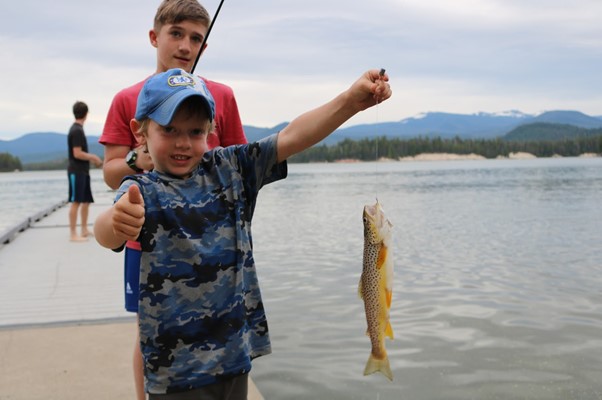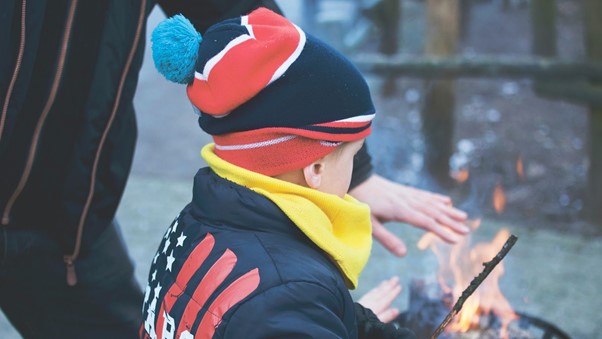Tips For Taking Your Kids Fishing
Guest Column
By Laurie Wilkins
As a parent, few things bring as much joy as watching your child enjoy the things you enjoy. Sharing a common interest with them makes an already immeasurably special relationship that much more special.
For avid anglers (or even the weekend fisherman), nothing could bring deeper joy to us than to see our kids learning the beautiful art of fishing. However, they’re not going to know how to spool or how to properly cast straight off the bat, and teaching them all of this can be daunting.
As with any fishing you do (or anything in life, really), poor preparation equates to poor performance, so if you’re looking to truly get the most from your child’s first trip, ensuring that you’ve adequately prepared is essential!
Freshwater is easily accessible (there are over 250 lakes in the US alone!), even in landlocked areas.

Generally, freshwater affords you a variety of fishing experiences, from large lakes to small creeks, and will often provide you the opportunity to fish a variety of bodies, without having to leave a single location.
The species that inhabit freshwater are less tricky to land as well, so choosing a great freshwater spot for your first trip may be a key factor in ensuring you and your family enjoy the day out.
Surf fishing is just as viable an option, as the beach offers activities for the kids to entertain themselves while waiting for a bite and piers provide all the benefits of being on a boat, without the risk of motion sickness or falling into the water.
Both freshwater and saltwater fishing can be great places to start.
Your determining factors should include the set-up you own, the species you are looking to hook, travel distance (no one wants to go fishing with children who have been cooped up in a car for 5 hours), and kid-friendliness (not too much brush, areas with no drop-offs at the water’s edge, and so on).
In my opinion, ditch the baby poles and go for something that will teach your kids to fish properly from day one.
You’ll form a basis on which they can grow and become great anglers in their own right, without needing to re-learn habits as they switch to the “big bog rods”.
It’s not only the rod you’ll want to keep in mind – the spinner that you choose will play a huge role in the ease-of-use of your rig – I’d recommend checking out my roundup of the highest quality reel for surf fishing.
Ask anyone what the “right bait for the job” is, and they’d give you a vastly different answer from the next person that you ask – and that’s just for one type of fish.
For beginners or those teaching beginners, I’d recommend fishing for easy to catch species in freshwater, such as sunnies, bass, and trout, and using live bait to do so.
Again, this is completely subjective, but I like to use live bait when taking kids fishing for a few reasons. One, the kiddos get to collect their bait themselves.

Digging up worms can be just as fun as the fishing itself for aspiring anglers.
The second reason is that it’s a great opportunity for kids to learn about the food chain and how each organism, no matter how seemingly insignificant, plays a huge role in its own ecosystem.
I mean, who doesn’t love a good biology lesson, right?
It’s not only the fish that’ll be biting (take snacks)
Take snacks that can be packed and eaten easily, such as crackers, sandwiches (avoid messy fillings), jerky, bags of nuts, and chicken nuggets.
I’d also recommend having plenty of water on hand, as a busy day outside can cause dehydration.
Even the strongest swimmers can suffer from fatigue, and a day on the water is taxing on even the most experienced fisherman among us.
As you likely know, an accidental fall into the water for a child can have devastating consequences.
When fishing with kids, ensure you have life jackets on hand (that fit) and a standard first aid kit.
You’ve prepared all the gear, now it’s time to prepare yourself!
Let’s chat about what you can expect on your first (few) fishing trips with the kids.
Expect the unexpected…
There is a great likelihood that things may not go as planned, and that’s all part of the fun. As with most things that involve children, there will likely be many encounters that you have not or could not have planned for – make this part of the fun!
Prepare to be flexible in the outcome of your day.
I have a friend whose son was more interested in pulling reeds out of the lake we were fishing in, than the fish themselves, but he had a blast and still learned about essentials like casting, baiting a hook, and having fun while fishing!
Given that the day may not go as planned, you may want to have a backup plan in mind. I always enjoy taking a picnic blanket on trips that I do with kids.
If they lose interest in fishing after a while or the fish aren’t biting that day, we sit and enjoy a nice picnic.
If you’re fishing at a camping ground, consider switching to a hike or roasting marshmallows, so that even if “Plan A” is not a success, “Plan B” will ensure that you and the family still enjoy the day!
I have a few friends who simply refuse to go fishing with me, no matter how hard I try to convince them to tag along.
Many of them say their early fishing experiences were ruined by an adult who made them sit quietly while they watched the adult have all the fun.
We want to avoid that, so let’s run through a few tips I would recommend for anyone trying to keep it “kid-friendly”.
There are few things that I have more fun doing than fishing.
The smells, the sights, the activity itself – it’s bliss.
If you’re taking your kids fishing, you likely love fishing just as much as I do and want to share that love with your kids.
Show your kids how to enjoy your passion in the same way that drives you to fish in the first place, by making it fun!
Don’t worry too much about whether you take home a catch that day or if they’re casting perfectly, but rather enjoy the activity that you’re doing with them because that’s what will make the trip special for them too!
Something that I see a lot of anglers doing at the local hole when teaching their kids to fish, is turning it into a lesson.
Let’s be real, that’s not what they want from the day.
I suggest setting yourself a list of goals based on what you want them to learn and spread it out over a few trips.
First, this gives you an excuse to turn a single trip into many.
The second reason you’ll want to do this is that you don’t center the excursion around learning to fish in one day, but rather small steps that will lead to a great outcome!
Even now, in my early 30’s, I make sure that any one-day fishing trips that I take see me enjoying an ice cream from the local shop on the way home.
Strange as it may sound, it’s a tradition my granddad started when he first introduced me to fishing.
Making a tradition of your fishing trips will create a positive association with the sport and create memories that your children will carry with them for life.
Winter Fishing
So now you’re all keen and ready to take the kids fishing, but the winter months are upon us…
Don’t let that get you down!

Winter fishing can be some of the most rewarding fishing you do, as the cold months mean many freshwater fish are grouping, all while the less committed anglers stay home and leave you to fish entire lakes on your own!
More fish, less competition? That sounds like a winning formula to me! Here are some tips for you and the kids to enjoy winter fishing together.
It goes without saying, but winter fishing is, well, cold.
Depending on where you’re doing your fishing, the temperature can drop below zero – not exactly shorts and T-shirt weather.
Dress in layers and take spare clothes.
Layers allow you to manage your body temperature while bringing extra clothes can save you if you find yourself wet and in need of dry, warm clothes.
Don’t forget your ice cleats either – they’ll probably be your most valuable accessory once you’re on the ice.
There are a bunch of extras that you can take along to make your trip more comfortable, and then there are some extras that you simply cannot go without. This includes sunscreen, blankets (extra for the kiddos), sleeping bags (take some time to investigate your options here), floatation device (life jackets, compact PFD, etc), and ice claws (preferably with a strap hang around the neck when not being worn).
Do your research before heading out!
This is especially true for winter fishermen, who will need to know the species they are hunting and the safest way to fish in the areas they are headed to.
Ice that is safe to walk on should be over four inches thick – if you’re unsure about ice thickness, contact the park or grounds managers where you plan to fish and enquire.
Keep an eye out for ice near the edge of the water body, as well as ice near debris, such as fallen trees and rocks.

Ice near these is generally thinner and susceptible to breaking.
Carrying a spud bar on you is a simple way to test the ice and ensure that it is safe to walk on.
When you have kids with you, it is advisable to have at least one other adult with you and to ensure that an adult walks in front and behind the group when walking on ice.
Two things that you’ll see a lot of when you search for anything related to ice fishing is “hypothermia” and “frostbite”.
Why?
Well, simply because you’re going to be facing extreme temperatures and the repercussions of poor preparation can be dire.
Laurie Wilkins is an Englishman who loves the outdoors. His fondness for all things wild started with climbing trees as a kid and over the years has expanded into fishing, hiking, camping, backpacking and survival.




